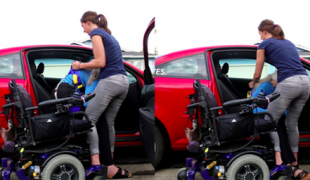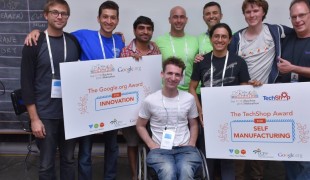- 4721
- 409
- 9
- 10
- 0
- Help Ukraine
About the solution
Wazeer Hayath once saw a blind man who was having trouble navigating on the street as several objects and people appeared on his way.
This inspired him to innovate. He created a special white cane that works as an ‘eye’ for blind people. Inside the cane there are battery-powered sensors. These sensors get activated and send an audio alert when they detect an object bigger than 2,54 cm (one inch).
“The speciality of this stick is that whenever there will be any pothole or marshy water or any other obstacle on a crowded road which generally people face then there will be sensors and six other applications to convey the message to the blind person,” said Wazeer.
After getting a viable design, he kept exploring different ways of changing the canes and ended up creating several high-tech sticks. Nowadays, he has patents for 5 different high-tech white canes.
The stick is programmed in 18 different languages, so that it reaches a bigger number of blind people.
Some of his ideas for the device include attaching a laser and sensor in the same device, having vibration and audio sound together and facilities for recharging the stick. He is also exploring a device that blind people could move around without a stick. This device would have sensors to detect obstacles, weigh less than 100 grams and have a mobile phone shape.
Currently, he is developing a scanner that identifies important buildings, markets and bus stops to help guide blind people in the city. However, in order to set up transmitters or relay points on the public building he will need support from the government.
Wazeer says his invention has contributed to making blind people more self-reliant.
He has since become an entrepreneur by creating the company Waz Technologies, where he sells his canes.
He makes the canes on order from different NGOs (Non-Governmental Organisations). The Blind Association of Australia, for example. has ordered 500 units.
Wazeer says there have also been international requests to buy his patents.
Adapted from: http://bit.ly/2lPFW7X
More info: http://bit.ly/2keWHJB
这些解决方案不应包括使用药物,化学品或生物制品(包括食品);创伤性设备;冒犯性的,商业或内在危险的内容。该解决方案未经医学验证。请谨慎进行!如果您有任何疑问,请咨询健康专家。
DISCLAIMER: This story was written by someone who is not the author of the solution, therefore please be advised that, although it was written with the utmost respect for the innovation and the innovator, there can be some incorrect statements. If you find any errors please contact the patient Innovation team via info@patient-innovation.com
-
-
245
-
0
-
2491

The Ramble Tag guidance aid - designed for use between guide and visually impaired person
WALKING WITH A WALKING AID: Walking with a walking aid
CAREGIVING
Hiking
Traveling
Blindness
Body-Worn solutions (Clothing, accessories, shoes, sensors...)
Walking Aid (wheelchair/walker/crutches)
Assistive Daily Life Device (to help ADL)
Strategy/Tip
Vision problems
Building Supportive Community Relationships
Promoting inclusivity and social integration
Maintaining Balance and Mobility
Preventing (Vaccination, Protection, Falls, Research/Mapping)
Caregiving Support
Ophthalmology
United Kingdom
-
-
-
377
-
0
-
6446

Harness to help transfer disabled and elderly people from wheelchair to the car
STANDING UP: Standing up from a seated position
WALKING WITH A WALKING AID: Walking with a walking aid
CAREGIVING
Mobility impairments
Assistive Daily Life Device (to help ADL)
Walking Aid (wheelchair/walker/crutches)
Promoting self-management
Maintaining Balance and Mobility
Caregiving Support
Neurology
Physical Medicine and Rehabilitation
United States
-
-
-
392
-
0
-
4425

Smart Ass – App and 3D device for wheelchair users
MOVING IN A WHEELCHAIR: Moving using a wheelchair.
CAREGIVING
Neuromuscular Disorders
Assistive Daily Life Device (to help ADL)
Walking Aid (wheelchair/walker/crutches)
3d Printed
Muscle cramps or spasms
Paralysis of the legs and lower body
Regaining sensory function
Managing pain
Promoting self-management
Preserving Organ Function
To implement a diagnostic tool
Maintaining Balance and Mobility
Restoring Blood Circulation
Preventing (Vaccination, Protection, Falls, Research/Mapping)
Caregiving Support
Dermatology
Internal Medicine
Orthopedics
United States
-
 zh
zh